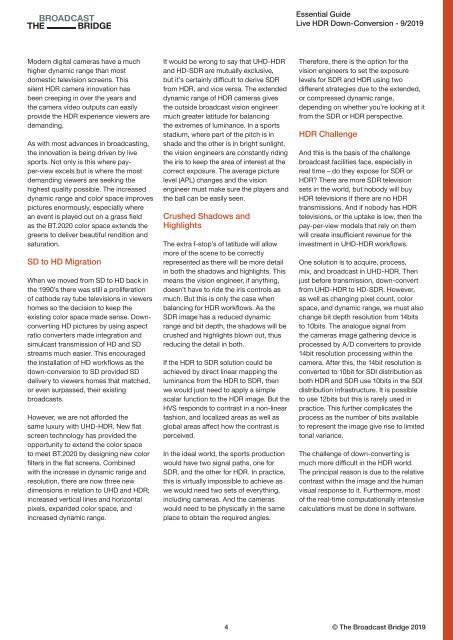ESSENTIAL GUIDE: Live HDR Down-Conversion
Essential Guide published by Broadcast Bridge in cooperation with LYNX-Technik AG discussing the challenges of live HDR-Down-conversion.
Essential Guide published by Broadcast Bridge in cooperation with LYNX-Technik AG discussing the challenges of live HDR-Down-conversion.
You also want an ePaper? Increase the reach of your titles
YUMPU automatically turns print PDFs into web optimized ePapers that Google loves.
Essential Guide<br />
<strong>Live</strong> <strong>HDR</strong> <strong>Down</strong>-<strong>Conversion</strong> - 9/2019<br />
Modern digital cameras have a much<br />
higher dynamic range than most<br />
domestic television screens. This<br />
silent <strong>HDR</strong> camera innovation has<br />
been creeping in over the years and<br />
the camera video outputs can easily<br />
provide the <strong>HDR</strong> experience viewers are<br />
demanding.<br />
As with most advances in broadcasting,<br />
the innovation is being driven by live<br />
sports. Not only is this where payper-view<br />
excels but is where the most<br />
demanding viewers are seeking the<br />
highest quality possible. The increased<br />
dynamic range and color space improves<br />
pictures enormously, especially where<br />
an event is played out on a grass field<br />
as the BT.2020 color space extends the<br />
greens to deliver beautiful rendition and<br />
saturation.<br />
SD to HD Migration<br />
When we moved from SD to HD back in<br />
the 1990’s there was still a proliferation<br />
of cathode ray tube televisions in viewers<br />
homes so the decision to keep the<br />
existing color space made sense. <strong>Down</strong>converting<br />
HD pictures by using aspect<br />
ratio converters made integration and<br />
simulcast transmission of HD and SD<br />
streams much easier. This encouraged<br />
the installation of HD workflows as the<br />
down-conversion to SD provided SD<br />
delivery to viewers homes that matched,<br />
or even surpassed, their existing<br />
broadcasts.<br />
However, we are not afforded the<br />
same luxury with UHD-<strong>HDR</strong>. New flat<br />
screen technology has provided the<br />
opportunity to extend the color space<br />
to meet BT.2020 by designing new color<br />
filters in the flat screens. Combined<br />
with the increase in dynamic range and<br />
resolution, there are now three new<br />
dimensions in relation to UHD and <strong>HDR</strong>;<br />
increased vertical lines and horizontal<br />
pixels, expanded color space, and<br />
increased dynamic range.<br />
It would be wrong to say that UHD-<strong>HDR</strong><br />
and HD-SDR are mutually exclusive,<br />
but it’s certainly difficult to derive SDR<br />
from <strong>HDR</strong>, and vice versa. The extended<br />
dynamic range of <strong>HDR</strong> cameras gives<br />
the outside broadcast vision engineer<br />
much greater latitude for balancing<br />
the extremes of luminance. In a sports<br />
stadium, where part of the pitch is in<br />
shade and the other is in bright sunlight,<br />
the vision engineers are constantly riding<br />
the iris to keep the area of interest at the<br />
correct exposure. The average picture<br />
level (APL) changes and the vision<br />
engineer must make sure the players and<br />
the ball can be easily seen.<br />
Crushed Shadows and<br />
Highlights<br />
The extra f-stop’s of latitude will allow<br />
more of the scene to be correctly<br />
represented as there will be more detail<br />
in both the shadows and highlights. This<br />
means the vision engineer, if anything,<br />
doesn’t have to ride the iris controls as<br />
much. But this is only the case when<br />
balancing for <strong>HDR</strong> workflows. As the<br />
SDR image has a reduced dynamic<br />
range and bit depth, the shadows will be<br />
crushed and highlights blown out, thus<br />
reducing the detail in both.<br />
If the <strong>HDR</strong> to SDR solution could be<br />
achieved by direct linear mapping the<br />
luminance from the <strong>HDR</strong> to SDR, then<br />
we would just need to apply a simple<br />
scalar function to the <strong>HDR</strong> image. But the<br />
HVS responds to contrast in a non-linear<br />
fashion, and localized areas as well as<br />
global areas affect how the contrast is<br />
perceived.<br />
In the ideal world, the sports production<br />
would have two signal paths, one for<br />
SDR, and the other for <strong>HDR</strong>. In practice,<br />
this is virtually impossible to achieve as<br />
we would need two sets of everything,<br />
including cameras. And the cameras<br />
would need to be physically in the same<br />
place to obtain the required angles.<br />
Therefore, there is the option for the<br />
vision engineers to set the exposure<br />
levels for SDR and <strong>HDR</strong> using two<br />
different strategies due to the extended,<br />
or compressed dynamic range,<br />
depending on whether you’re looking at it<br />
from the SDR or <strong>HDR</strong> perspective.<br />
<strong>HDR</strong> Challenge<br />
And this is the basis of the challenge<br />
broadcast facilities face, especially in<br />
real time – do they expose for SDR or<br />
<strong>HDR</strong>? There are more SDR television<br />
sets in the world, but nobody will buy<br />
<strong>HDR</strong> televisions if there are no <strong>HDR</strong><br />
transmissions. And if nobody has <strong>HDR</strong><br />
televisions, or the uptake is low, then the<br />
pay-per-view models that rely on them<br />
will create insufficient revenue for the<br />
investment in UHD-<strong>HDR</strong> workflows.<br />
One solution is to acquire, process,<br />
mix, and broadcast in UHD-<strong>HDR</strong>. Then<br />
just before transmission, down-convert<br />
from UHD-<strong>HDR</strong> to HD-SDR. However,<br />
as well as changing pixel count, color<br />
space, and dynamic range, we must also<br />
change bit depth resolution from 14bits<br />
to 10bits. The analogue signal from<br />
the cameras image gathering device is<br />
processed by A/D converters to provide<br />
14bit resolution processing within the<br />
camera. After this, the 14bit resolution is<br />
converted to 10bit for SDI distribution as<br />
both <strong>HDR</strong> and SDR use 10bits in the SDI<br />
distribution infrastructure. It is possible<br />
to use 12bits but this is rarely used in<br />
practice. This further complicates the<br />
process as the number of bits available<br />
to represent the image give rise to limited<br />
tonal variance.<br />
The challenge of down-converting is<br />
much more difficult in the <strong>HDR</strong> world.<br />
The principal reason is due to the relative<br />
contrast within the image and the human<br />
visual response to it. Furthermore, most<br />
of the real-time computationally intensive<br />
calculations must be done in software.<br />
4 © The Broadcast Bridge 2019





